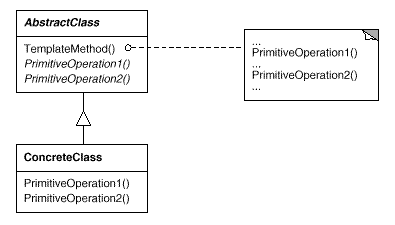- Intent: Define the skeleton of an algorithm in an operation, deferring some steps to subclasses. It lets subclasses redefine certain steps of an algorithm without changing its structure
Structure §

Image from: Gamma, Helm, Johnson, and Vissides
Applicability §
- Implement the invariant parts of an algorithm once and leave it up to subclasses to implement behavior they can vary
- When common behavior among subclasses should be factored localized in a common class to avoid code duplication.
- Control subclasss extensions
Consequences §
- Allows factoring out common behavior.
- Lead to an inverted control structure where the parent class calls the operations of a subclass.
- Hook operations (which may be overridden) and abstract operations (which must be overridden) must be distinguished.
Implementation §
- Use access controls so primitive operations can only be called by the template method.
- Minimize primitive operations
